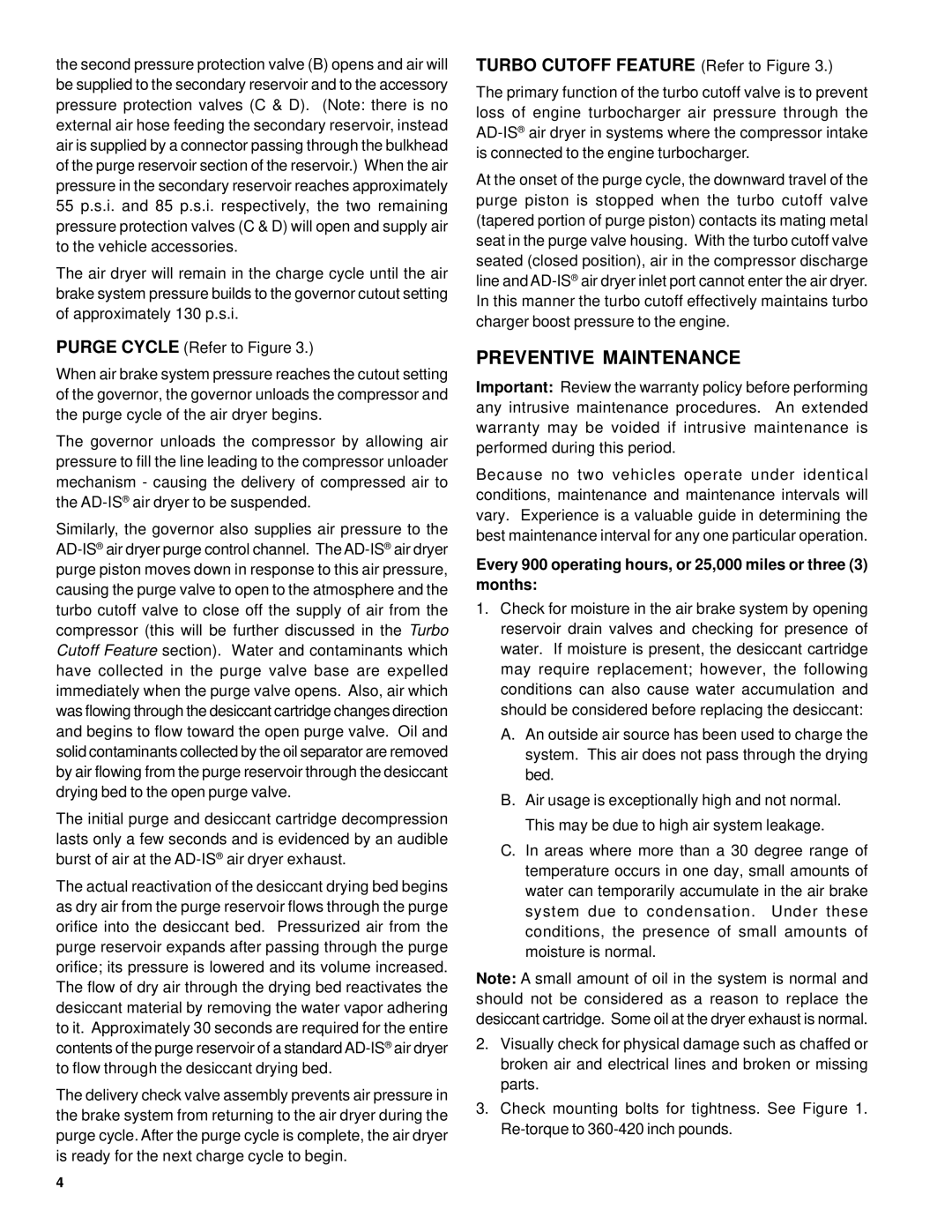the second pressure protection valve (B) opens and air will be supplied to the secondary reservoir and to the accessory pressure protection valves (C & D). (Note: there is no external air hose feeding the secondary reservoir, instead air is supplied by a connector passing through the bulkhead of the purge reservoir section of the reservoir.) When the air pressure in the secondary reservoir reaches approximately 55 p.s.i. and 85 p.s.i. respectively, the two remaining pressure protection valves (C & D) will open and supply air to the vehicle accessories.
The air dryer will remain in the charge cycle until the air brake system pressure builds to the governor cutout setting of approximately 130 p.s.i.
PURGE CYCLE (Refer to Figure 3.)
When air brake system pressure reaches the cutout setting of the governor, the governor unloads the compressor and the purge cycle of the air dryer begins.
The governor unloads the compressor by allowing air pressure to fill the line leading to the compressor unloader mechanism - causing the delivery of compressed air to the
Similarly, the governor also supplies air pressure to the
The initial purge and desiccant cartridge decompression lasts only a few seconds and is evidenced by an audible burst of air at the
The actual reactivation of the desiccant drying bed begins as dry air from the purge reservoir flows through the purge orifice into the desiccant bed. Pressurized air from the purge reservoir expands after passing through the purge orifice; its pressure is lowered and its volume increased. The flow of dry air through the drying bed reactivates the desiccant material by removing the water vapor adhering to it. Approximately 30 seconds are required for the entire contents of the purge reservoir of a standard
The delivery check valve assembly prevents air pressure in the brake system from returning to the air dryer during the purge cycle. After the purge cycle is complete, the air dryer is ready for the next charge cycle to begin.
TURBO CUTOFF FEATURE (Refer to Figure 3.)
The primary function of the turbo cutoff valve is to prevent loss of engine turbocharger air pressure through the
At the onset of the purge cycle, the downward travel of the purge piston is stopped when the turbo cutoff valve (tapered portion of purge piston) contacts its mating metal seat in the purge valve housing. With the turbo cutoff valve seated (closed position), air in the compressor discharge line and
PREVENTIVE MAINTENANCE
Important: Review the warranty policy before performing any intrusive maintenance procedures. An extended warranty may be voided if intrusive maintenance is performed during this period.
Because no two vehicles operate under identical conditions, maintenance and maintenance intervals will vary. Experience is a valuable guide in determining the best maintenance interval for any one particular operation.
Every 900 operating hours, or 25,000 miles or three (3) months:
1.Check for moisture in the air brake system by opening reservoir drain valves and checking for presence of water. If moisture is present, the desiccant cartridge may require replacement; however, the following conditions can also cause water accumulation and should be considered before replacing the desiccant:
A.An outside air source has been used to charge the system. This air does not pass through the drying bed.
B.Air usage is exceptionally high and not normal. This may be due to high air system leakage.
C.In areas where more than a 30 degree range of temperature occurs in one day, small amounts of water can temporarily accumulate in the air brake system due to condensation. Under these conditions, the presence of small amounts of moisture is normal.
Note: A small amount of oil in the system is normal and should not be considered as a reason to replace the desiccant cartridge. Some oil at the dryer exhaust is normal.
2.Visually check for physical damage such as chaffed or broken air and electrical lines and broken or missing parts.
3.Check mounting bolts for tightness. See Figure 1.
4
